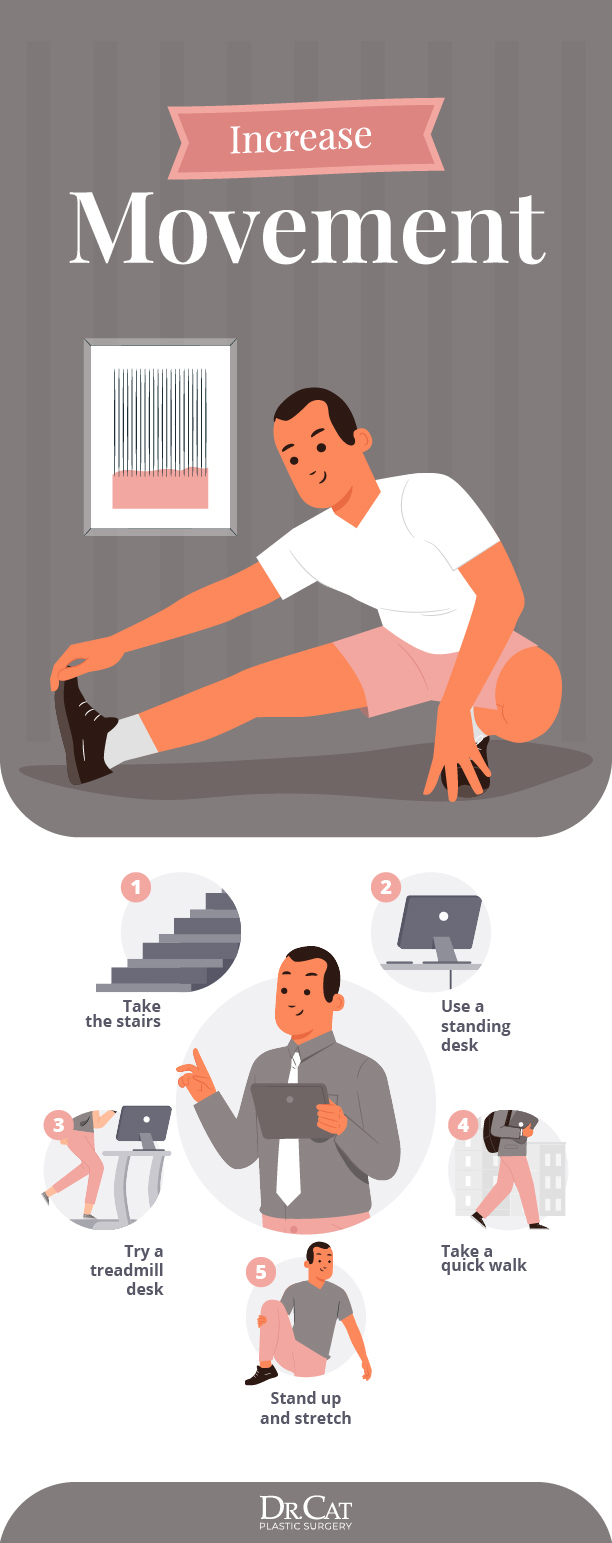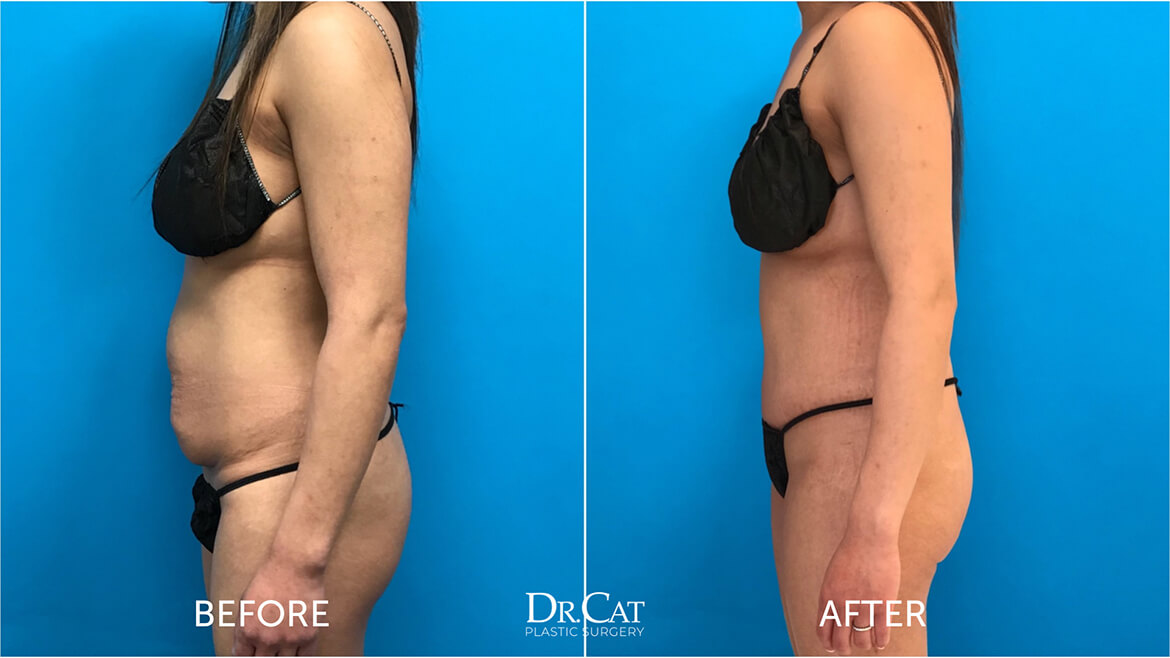Are you always choosing baggy clothing to hide the stubborn skin that never seems to go away? Whether you want a bikini body for summer or you are looking for ways to fit back into your favorite jeans, there are a few things that you can do to get a flat stomach again.
3 Factors Affecting Stomach Shape
Weight loss is an essential factor when trying to achieve a flat stomach, but there are a few other things that will also affect the shape and appearance of your stomach:
- Fat Distribution: Some people are more prone to belly fat, and it can be difficult to reduce. Each body is unique, and fat storage happens in different areas, such as the stomach, thighs, butt, and more. If you are someone who tends to gain weight in the stomach area, then overall weight loss can help to slim down your midsection.
- Bloating: Another common issue that affects the stomach’s appearance is how much the digestive system is bloated. Do you find that you have a lot of gas and bloating? Even if you aren’t carrying much stomach fat, it can still cause the stomach to look distended because of the bloating.
- Toned Muscles: Finally, another factor that affects whether your stomach is flat or rounded is the muscle tone you have in this area. If you want a flatter stomach, toning the muscles can help define the overall appearance of your midsection. Post-pregnancy, women may have stretched stomach muscles, giving the appearance of a round stomach.
Improving one of these factors can have a notable impact on the overall appearance of your stomach. If you are proactive about improving 2 or 3 factors, then it can make a big difference in helping you achieve the flatter stomach that you desire.

Not only does stomach fat affect your overall appearance, but it also has an impact on health as well. For example, this type of fat can increase the risk of type 2 diabetes, heart disease, and more.
Flat Stomach Tips: Effective Solutions for Improving Stomach Shape
The truth is that there isn’t one solution to get a flatter stomach. Instead, the small decisions you make throughout the day will add up to the overall results that you desire. If you want a flatter stomach, then try these different tips to find the solutions that work best for your body type:
1. Eat Six Small Meals Each Day
You want to keep your metabolism firing throughout the day, and this happens because of the way you are structuring your meals. Eating smaller meals more frequently throughout the day is the best solution for high metabolism.
Ideally, decrease your portion sizes, then prioritize eating five or six times per day. Not only will frequent meals help you avoid intense hunger, but the healthy ingredients can also keep your body fueled and out of starvation mode – which can reduce the body’s response to store fat.
2. Stay Hydrated
 How much water are you drinking throughout the day? Even though some people are worried about “water weight,” one tip for avoiding water retention is to drink quality water throughout the day. In fact, people often find that water weight happens more frequently when they consume too much sodium and not enough water.
How much water are you drinking throughout the day? Even though some people are worried about “water weight,” one tip for avoiding water retention is to drink quality water throughout the day. In fact, people often find that water weight happens more frequently when they consume too much sodium and not enough water.
Drinking water supports digestion and can relieve bloating because it reduces constipation. Additionally, staying hydrated can also increase your metabolism.
One other benefit of drinking water throughout the day is that it helps your stomach feel full, which can reduce the amount of food you are eating. For example, some people think that they are hungry, but they are actually experiencing cues to drink more water.
If you think that you want a snack, try drinking a glass of water and then wait for 20 minutes. You’ll likely find that the water helps the hunger cues to subside so that you can wait until your next meal before eating.
3. Consider Your Macros
Start tracking your food to look at the balance of carbohydrates, fat, and protein. For the best results, talk to a nutritionist who can offer personalized recommendations for your unique needs and body type.
One general recommendation that works for a lot of people is to decrease carbohydrate intake. When someone is eating a lot of carbohydrates, then it affects blood sugar fluctuations, which increases fat storage. Reduce carbs and increase protein consumption. At the same time, make sure you are getting a bit of healthy fat to keep you feeling satiated throughout the day.
4. Choose the Right Carbohydrates
When you are eating simple carbohydrates such as refined sugar, white rice, and white bread, these foods spike the blood sugar and increase fat storage. Additionally, many people feel bloated when they eat a lot of simple carbohydrates.
If you are trying to lose belly fat and decrease bloating, choose complex carbohydrates in their natural form instead. Examples include brown rice, sweet potatoes, and whole bread.
5. Increase Fiber Intake
Fruits, vegetables, and whole grains contain fiber, which helps you feel full all day long. Additionally, fiber consumption is important for supporting digestion, which helps everything move through the stomach and bowels at the right pace.
Make sure you are including soluble fiber in your meals, so you don’t get hungry between meals. Examples of soluble fiber include black beans, sweet potatoes, lentils, oats, and fresh fruit.
6. Eat More Lean Protein
Protein consumption plays a role in overall hunger and satisfaction. Not only will lean protein help you feel full for longer, but it also contains the building blocks necessary to help with muscle growth and repair.
Many people find that high-quality protein consumption has a direct impact on reducing belly fat. You can include a variety of protein sources in your diet, such as beef, eggs, chicken, and milk.
7. Use Quality Fats
Don’t make the mistake of thinking that you need to avoid fat in your foods if you are trying to lose belly fat. The truth is that consuming healthy fats is an important part of a well-balanced diet. Your body needs these fat sources for optimal health and wellness.
Stay away from highly processed fats that can be damaging to your health, such as vegetable oils like canola oil or sunflower oil. Consuming small amounts of monounsaturated fatty acids in your meals is a better solution. Ingredients with these healthier fats include nuts, olive oil, avocado, natural peanut butter, and sesame oil.
8. Stay Away from High-Calorie Drinks
Even though it might be nice to sip on a cold soda throughout the day, these high-calorie drinks add hundreds of calories to your diet. It’s easy to over-indulge in sugar and too many calories when drinking the calories instead of eating them.
Some of the biggest offenders include soda, sweetened coffee, and energy drinks. But also, be aware of juice and milk. Even though these drinks seem like healthier options, they are still high in calories and can spike blood sugar levels.
It’s best to avoid juice and eat fresh fruit instead. Also, keep a bottle of water on hand throughout the day as an alternative to soda. If you want to add a little flavor, try dropping a few pieces of fresh fruit or mint into your water bottle. Lemon, strawberries, and mint are great combinations to freshen the water and make it more enjoyable!
9. Write Down Food and Drinks
Do you know how many calories you are consuming each day? Most people are eating more than they realize! Using a food tracking journal can bring more awareness to everything that is going into your mouth. Then, you can be more mindful about making healthy decisions for snacks and meals.
In addition to calorie monitoring, meal tracking can help you see if you are getting key nutrients. If you don’t want to write your food in a notebook, try using a free food-tracking app such as MyFitnessPal. This type of tool helps you see calorie consumption, and you can also track macros easily and efficiently.
10. Identify Food Sensitivities
If you have allergies or food sensitivities, these ingredients could affect your stomach and cause bloating. Often, food sensitivities contribute to bloating and inflammation. So, cutting these ingredients from your diet can have an undeniable impact on helping you achieve a flatter stomach.
Common offenders include gluten, eggs, and dairy. Pay attention to how you are feeling after eating different types of food. Also, it can be helpful to visit a doctor for allergy testing. A nutritionist or dietician can be an excellent resource for planning delicious and healthy meals without offending ingredients.
11. Prioritize Cardio Throughout the Week
It’s no surprise that regular exercise is essential to help with fat loss. When you are consistent with exercise, it helps to burn fat and keep your metabolism firing throughout the day.
Make sure you are scheduling time for cardio activities throughout the week. Examples include cycling, running, or taking an aerobics class.
The general recommendation is to have 5 cardio sessions per week for 30 – 45 minutes per session. But keep in mind that you might need to work your way up to these levels if you haven’t been exercising. So, start with lower intensity and shorter workouts. Then, increase your time and intensity as you build endurance over time.
12. Increase Movement

In addition to scheduling time for exercise sessions, look for small, incremental ways to increase movement throughout the day. Even a little bit of activity can make a big difference in increasing calorie burning. Boosting movement is especially important if you spend most of the day in school or sitting at a desk for work.
Look for ways to add small movements, and try to stand up at least once an hour. Examples include:
- Take the stairs instead of the elevator
- Use a standing desk instead of sitting
- Try a treadmill desk
- Take a quick walk around the building
- Stand up and stretch
13. Don’t Forget Strength Training
While cardio can burn calories quickly and efficiently, it’s also important to ensure that you are building muscle during your workouts. The more your muscle mass increases, the higher your metabolism.
There are different ways that you can incorporate muscle-building into your exercise routine. In fact, some programs include both cardio and muscle building at the same time. One example is CrossFit, which offers a full-body workout that also builds muscle over time.
14. Decrease Stress

Did you know that stress responses within the body cause an increase in cortisol? When this hormone goes up, then the body goes into fat-storage mode. The higher your stress levels, the more cortisol is released. As a result, your metabolism slows down, and your blood sugar regulation is affected.
Don’t underestimate the way stress affects your body. It has an undeniable impact on hormone levels, which changes the way your body digests. If you are constantly in “fight or flight,” it affects your hormones, metabolism, and fat storage.
Stress reduction can be simple and might include the following:
- Simplify your schedule by eliminating unnecessary meetings and appointments
- Exercise to boost your mood and release tension
- Try meditation and mindfulness
- Finish important tasks, so they aren’t at the top of your mind
- Go on vacation so you can get a break from work and daily responsibilities
- Prioritize fun and relaxing hobbies
15. Improve Sleep Hygiene

Not only will you have dark circles under your eyes if you aren’t getting enough sleep, but a lack of sleep also affects your metabolism. Sleep is another factor that can affect hormone levels and will have an undeniable impact on your stress levels as well.
Some people find that if tired, there is a higher risk of snacking throughout the day, which can increase overall calorie consumption and lead to fat storage. If you are sleep deprived, you might have more sugar cravings throughout the day to increase energy levels.
Additionally, it’s harder to stay motivated with diet and exercise goals if you are too tired. When you want to lay down to nap, there might be a bigger temptation to skip a workout or stop by a fast-food drive-thru instead of cooking a healthy dinner.
Improve your sleep quality and habits by following these tips:
- Turn off all screens (phone, TV, and computer) an hour before bedtime
- Set an alarm to remind you 30 minutes before bedtime
- Try meditation or stretching before bed
- Exercise earlier in the day so you are tired when it’s time to sleep
- Avoid alcohol and caffeine in the afternoon and evening
- Set your circadian rhythm by getting sunlight exposure first thing in the morning
16. Decrease or Avoid Alcohol
In addition to beer, wine, and mixed drinks being high in calories, these drinks can also affect your digestion and metabolism. Consuming alcohol regularly takes a toll on the digestive system and can even reduce overall nutrient absorption.
Another drawback of alcohol consumption is the way it can affect sleep patterns and snacking habits. For example, if you tend to snack more in the late evening when you drink, it can increase your fat storage over time.
Most people find that moderate drinking, such as a maximum of one drink per day, is fine. But if you are trying to achieve fast results, you might avoid alcohol completely for a while.

17. Talk to a Plastic Surgeon for a Tummy Tuck
If you’ve tried diet and exercise without success, it might be time to consider a proven method for achieving a flatter stomach: a tummy tuck. Many women find that hormones, pregnancy, and genetics can make it hard to lose the extra weight, especially in their 40s, 50s, and beyond.
Even though you haven’t been able to achieve the tight, toned tummy that you desire, there are solutions to get these results by working with an experienced surgeon. The best solution is to schedule a consultation so you can see if a tummy tuck is a proper treatment for your needs.
Here is an overview of how a tummy tuck works to create the flat stomach that you desire:
- Incision: The first step is for the surgeon to make an incision between the pubic and belly area. Sometimes, a second incision is necessary around the belly button. This small incision gives the surgeon access to the areas that need to be treated.
- Tightening Muscles: Next, the damaged muscles under the skin and fat can be repaired to ensure they are positioned correctly. It’s important to align these muscles to improve your abdominal function and also manage the overall appearance of the stomach.
- Removing Fat and Skin: The incision also gives the surgeon access to remove excess fat and skin to tighten the stomach. After the stomach stretches with pregnancy and weight gain, there is often an increased amount of fat and skin in the abdominal area that must be removed.
- New Navel: Depending on how the stomach skin and overall layout turn out, it might be necessary for the surgeon to create a new belly button. The goal is to make it look as natural as possible.
- Closing the Incisions: The last step is to stitch everything up and close the incisions. Everything needs to be held in place to ensure proper healing and recovery.
Immediately after the tummy tuck surgery, your stomach will feel tender and swollen. But these symptoms will continue to decrease in the weeks and months of your recovery. Following the surgeon’s recommendations during this time is important to ensure optimal healing.
Once everything is healed, you will be able to return to your normal activities once again. Your stomach will be flat and look great, giving you the benefit of more confidence and improved self-esteem.
 Consult an Experienced Plastic Surgeon
Consult an Experienced Plastic Surgeon
Do you want to see if you are a good candidate for a tummy tuck? Achieve the flat stomach you desire by scheduling a consultation with Dr. Cat Begovic. In addition to tummy tucks, Dr. Cat offers mommy makeovers and other surgical interventions to help you feel more comfortable and happier about your appearance.
Dr. Cat is a board-certified surgeon with years of experience in the cosmetic surgery industry. Book an appointment to learn more about the various treatments that can help you achieve the body that you desire.

 Consult an Experienced Plastic Surgeon
Consult an Experienced Plastic Surgeon
